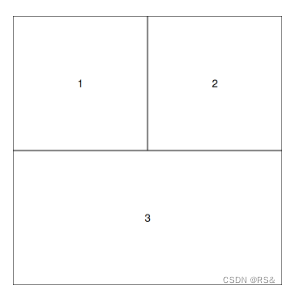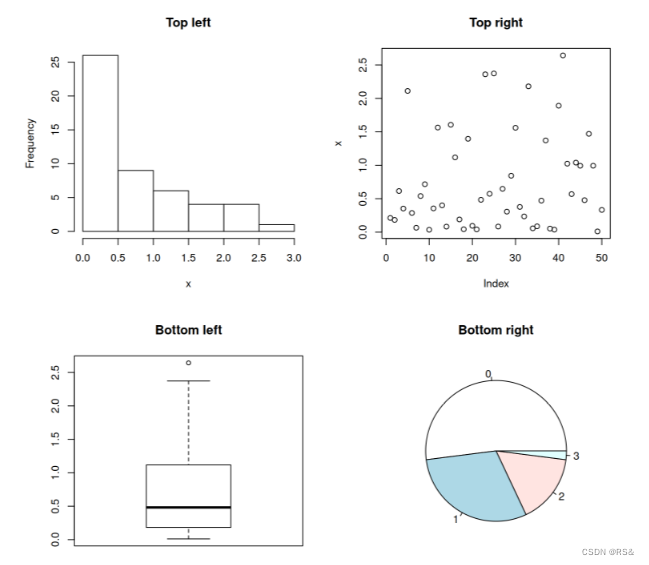参考资料:
https://mp.weixin.qq.com/s/5c7gpO2mJ2BqJevePJz3CQ
tricolore包教程:https://github.com/jschoeley/tricolore
学习笔记:Ternary choropleth maps
1、测试实例
代码:
library(ggplot2)
library(rnaturalearthdata)
library("tricolore")#用于绘制三元地图
library("ggtern")#设置图例#test
# 生成模拟数据
P <- as.data.frame(prop.table(matrix(runif(3^6), ncol = 3), 1))
# 使用Tricolore生成需要的数据:该步骤最为重要
colors_and_legend <- Tricolore(P, 'V1', 'V2', 'V3')
# 展示生成的数据(部分)
head(colors_and_legend$rgb)
# colors_and_legend$key#显示作为图例的三元相图
#地图绘制
# color-code the data set and generate a color-key
#用Tricolore()函数,对euro_example数据集中的每个教育组成进行颜色编码,
#并将生成的十六进制srgb颜色向量作为新变量添加到数据帧中,颜色键单独存放
tric_educ <- Tricolore(euro_example,p1 = 'ed_0to2', p2 = 'ed_3to4', p3 = 'ed_5to8')#将生成的颜色向量存放到数据集中
# add the vector of colors to the `euro_example` data
euro_example$educ_rgb <- tric_educ$rgb
#绘制地图
plot_educ <-# using data sf data `euro_example`...ggplot(euro_example) +# ...draw a choropleth mapgeom_sf(aes(fill = educ_rgb, geometry = geometry), size = 0.1) +# ...and color each region according to the color-code# in the variable `educ_rgb`scale_fill_identity()#设置图例
plot_educ +annotation_custom(ggplotGrob(tric_educ$key +labs(L = '0-2', T = '3-4', R = '5-8')),#tric_educ$keyxmin = 55e5, xmax = 75e5, ymin = 8e5, ymax = 80e5)
代码来源:https://github.com/jschoeley/tricolore
结果:

2、R语言绘图学习
(1)绘图布局设置
方法一、layout()函数:
layout(mat, widths = rep.int(1, ncol(mat)),
heights = rep.int(1, nrow(mat)), respect = FALSE)
使用方法:
l <- layout(matrix(c(1, 2, # First, second3, 3), # and third plotnrow = 2,ncol = 2,byrow = TRUE))
layout.show(l)
结果:

还可以设置不同行之间的比例:(如第三行是第一行的3倍)
mat <- matrix(c(1, 1, # First2, 3), # second and third plotnrow = 2, ncol = 2,byrow = TRUE)
layout(mat = mat,heights = c(1, 3)) # First and second row# relative heights
方法二、par() 函数:
使用方法:
# Data
set.seed(6)
x <- rexp(50)# Two rows, two columns
par(mfcol = c(2, 2))# Plots
hist(x, main = "Top left") # Top left
boxplot(x, main = "Bottom left") # Bottom left
plot(x, main = "Top right") # Top right
pie(table(round(x)), main = "Bottom right") # Bottom right# Back to the original graphics device
par(mfcol = c(1, 1))

图片来源:https://r-charts.com/base-r/combining-plots/
(2)加载点矢量数据,并显示在地图上
library(sf)
library(ggplot2)
library(rnaturalearthdata)#加载点shp,并显示
points_shp <- st_read("path/points.shp")#绘制全球海岸线
coast <- ne_coastline(scale = "small", returnclass = "sf")
xlim <- c(-175, 175) # 经度范围
ylim <- c(-55, 80) # 纬度范围ggplot(data = coast) +geom_sf() +coord_sf(xlim = xlim, ylim = ylim) +theme_classic()+geom_sf(data = points_shp, color = "red", size = 2)(3)根据某变量大小显示点的大小
可以直接设置size=points_shp$v1,但一一般情况下,需要自己根据值来定义具体大小:
安装包:install.packages("dplyr")
points_shp <- points_shp %>% mutate(size = case_when(v1 > 0.8 ~ 9,v1 > 0.6 & v1 <= 0.8 ~ 4,TRUE ~ 1 # 默认情况下设置为1))
调用:geom_sf(data = points_shp, aes(size = size), color = "red")绘制不同大小的点。
aes是"aesthetic"的缩写,用于ggplot2包中的函数,用来映射数据到图形属性,例如颜色、形状、大小等。
(4)点显示为圆环
geom_sf(data = points_shp, aes(size = size), shape = 21, fill = "transparent", color = "red", stroke = 2)
其中,shape = 21表示将点的形状设置为圆环,fill = "transparent"表示圆环内部透明填充,color = "red"表示圆环的颜色为红色,stroke = 2表示圆环的线宽为2。




winform(支持全屏)自动适应x86、x64平台插件及重要代码)




—— 绑定路径和数据上下文)





)

![[Qt]Qt中的QPainter绘制在哪的问题](http://pic.xiahunao.cn/[Qt]Qt中的QPainter绘制在哪的问题)

